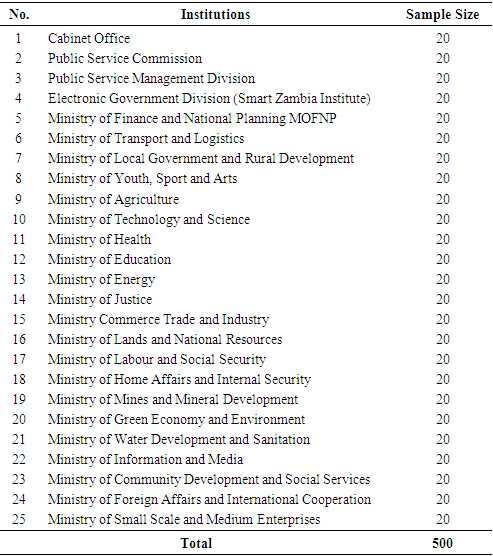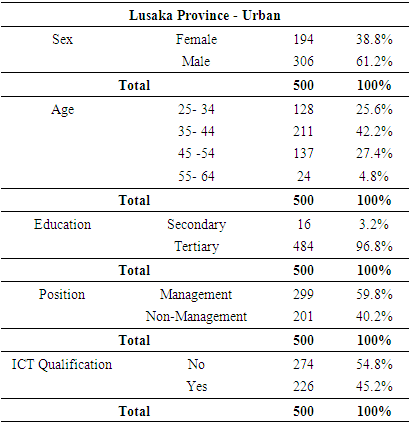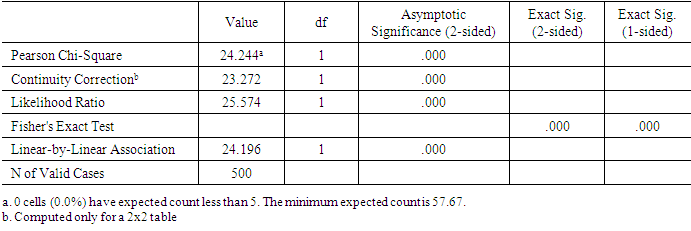-
Paper Information
- Paper Submission
-
Journal Information
- About This Journal
- Editorial Board
- Current Issue
- Archive
- Author Guidelines
- Contact Us
International Journal of Networks and Communications
p-ISSN: 2168-4936 e-ISSN: 2168-4944
2025; 14(1): 1-9
doi:10.5923/j.ijnc.20251401.01
Received: Jan. 4, 2025; Accepted: Feb. 3, 2025; Published: Apr. 16, 2025

Utilization of e-Gov Shared Services by Civil Servants
Bentry Bwalya, Simon Tembo
Department of Electrical and Electronics, University of Zambia, Lusaka, Zambia
Correspondence to: Bentry Bwalya, Department of Electrical and Electronics, University of Zambia, Lusaka, Zambia.
| Email: |  |
Copyright © 2025 The Author(s). Published by Scientific & Academic Publishing.
This work is licensed under the Creative Commons Attribution International License (CC BY).
http://creativecommons.org/licenses/by/4.0/

Despite the prevalent installation of digital technology in the central government institutions in Lusaka Province of Zambia, little attention has been given to understanding the utilization of e-government shared services by the civil service employees. Shared services in the context of this study are the information and Communication Technologies functions that have been deployed on the Government Wide Area Network to better serve the public service and improve efficiency and reduce cost. This paper examines the level of civil service employees’ ICT awareness and the extent to which they understand and support e-government through the utilization of shared services. A structured electronic questionnaire was administered online to gather data from the central government employees in Lusaka Province. According to the results, surveyed employees rated their general computer literacy as high. They are able to operate basic computing devices to access the internet. The findings also indicate that most employees accepted e-government, but they are less satisfied with its implementation. However, despite the implemented e-government shared services, the study findings show that employees still do not access most of the shared services that are already online with the e-Payslip being the most accessed online service. The study fills the gap in research by focusing on central government employees in Lusaka Province rather than general citizenry. It also contributes to the identification of factors that may influence e-government adoption such as sensitization and training. The paper concludes with policy recommendations for successful implementation of e-government.
Keywords: E-government, Shared Services, Government Wide Area Network (GWAN), Civil Servants
Cite this paper: Bentry Bwalya, Simon Tembo, Utilization of e-Gov Shared Services by Civil Servants, International Journal of Networks and Communications, Vol. 14 No. 1, 2025, pp. 1-9. doi: 10.5923/j.ijnc.20251401.01.
Article Outline
1. Introduction
- In recent years, growth of the Information and Communication Technology (ICT) has had a substantial impact on the way local, state and national governments function [1]. Information and Communication Technology (ICT) refers to technologies such as the Internet, Intranets, Extranets and other such technologies that cover the spectrum from basic infrastructure implementation to technologies that improve services and operations in an organization. Use of ICT in government, popularly known as e-government, has been on the rise. E-government is described as the use of technology to enhance access to, and delivery of, government services to benefit citizens, business partners and employees at local, municipal, state and national levels [2]. The Government of the Republic of Zambia commenced implementing the ambitious e-government in 2006 under the charge of the former Ministry of Transport and Communication [3]. The government had noticed a gap between certain groups of people within the country as a result of several factors. One such factor was inequitable access to information among the citizenry because of lack of technology. The comparison between a developed country and a developing country like Zambia shows one fundamental difference. The former is rich in information and have a well-informed citizenry which is able to adapt quickly to changing social and economic environments. The information divide presents barriers by denying the people to seize an opportunity and make them applicable in the possible ways. Zambia had been showing a higher propensity to indigenous knowledge systems which are full of inefficiencies and operation in silos, a lot of red tape in public service delivery, and prone to corrupt and inefficient practices. The e-government was identified as a commodity which had potential to make significant changes in many aspects of the Zambia’s governance and economic development. E-government has been adopted as one of the most efficient vehicles for appropriate service delivery, transparency, inclusivity, participatory, decision making and cost saving.
1.1. Historical Perspective of e-government in Zambia
- The genesis of formal e-government implementation in Zambia could be traced to the year 2006 when the government developed the first ever National ICT Policy. This Policy was premised on thirteen pillars which were categorized into three thematic areas; (i) Capacity Building and Infrastructure Development; (ii) Building a competitive and efficient ICT sector; and (iii) Putting in place an effective legal and regulatory framework. In 2009, the government passed the Electronic and Communication Transaction Act No. 21 of the laws of Zambia, whose purpose was to provide an enabling environment for conducting electronic communication transactions. As a part of the measure to further the implementation of the National ICT Policy, the government in 2013 undertook to develop the "Public Service Transformation Strategy" which was meant to be implemented during the period 2013 – 2016. Under this Strategy, e-government was seen as a vehicle to transform the way the government interacted with and delivered services to citizens, businesses and across government departments and agencies. Alongside the transformation strategy, in 2013 the government developed the first ever E-government Strategic and Implementation Plan 2013 – 2017, to guide the implementation of the e-government programme in the country. The Government embarked on the e-government programme that aimed to transform how the Government interacted and delivered services to citizens, businesses and across government departments and agencies. It was envisaged that the e-government programme would result in a totally new and smart way of doing business in the public service. At National level, the importance of ICT in national development is demonstrated by the inclusion of ICT as a priority sector in the revised Sixth National Development Plan, SNDP 2013 - 2016, the Seventh National Development Plan, SNDP 2017-2021 and now the Eighth National Development Plan, ENDP, 2022-2026. In line with the presidential directive for Specific, Measurable, Achievable, Realistic, and Timely (SMART) public service delivery, the SMART Zambia Institute (SZI) under the Office of the President and as a Divisions under Cabinet Office, was established through a Government Gazette Notice No. 836 dated 18th November 2016 whose mandate was to implement e-government in order to support improved public service delivery. The Smart Zambia Institute, also known as the Electronic-Government Division, was launched in 2015. The ICT sector in Zambia has relevant policies, legislations and regulations that include; (i) National Information and Communication Technologies Policy 2023 (ii) National Information and Communication Technologies Policy Implementation Plan 2022-2023 (iii) National Information and Communication Technologies strategic and implementation Plan 2023-2027 (iv) Information and Communication Technologies Act of 2009 (v) Electronic and Communication Technologies Act, 2021 (vi) Data Protection Act, 2021 (vi) Electronic Government Act, 2021.
1.2. Features of e-government
- In terms of characteristics of e-government, there seems to be no distinctive characteristic of e-government, however, its features are explained based on different understanding. In terms of electronic transactions and interactions between government and other main groups – citizens, businesses, employees and other governments and public bodies, four main blocks of e-government have been classified: a) Government to Citizen (G2C): Allows citizens to retrieve information and complete government transaction e.g. license renewals. b) Government to Employee (G2E): Government interacting with employee online. c) Government to Government (G2G): Online communication and interaction amongst government agencies. d) Government to Business (G2B): Allows businesses to retrieve government information and complete transactions with government agencies e.g. bid submission [4].
1.3. Statement of the Problem
- ICT infrastructure is recognized to be one of the main challenges for e-government. Whilst the developing countries have low IT literacy level compared to the developed countries, the evolving change in the global world and the need for developing countries to meet up with technological advancement calls for transformation. Towards the end of 2013 fiscal year, the Ministry of Transport, Works Supply and Communication (MTWSC), through the Department of Communications in collaboration with the key stakeholders kick-started the implementation and deployment of e-government Infrastructure. A phased approach was applied which segmented the project into three phases. Phase one (01) involved interconnection of the selected twenty-five institutions to the National Data Centre within Lusaka. This process included the development of the High-Level Design, Low-Level Design documents and the deployment of e-government Highway Data Transport Layer equipment. The Carrier Grade Router (CRS-3) for government which is the main equipment in the design and a provider edge (PE) router were procured, stacked and racked at Zamtel as a service provider. The other Provider Edge equipment was installed at National Data Centre to provide collaboration for the shared and non-shared electronic services envisioned by government. This equipment forms a core data transport layer for the e-government services. Seven (07) new customer premises equipment (CPEs) were procured and delivered in seven different institutions including Cabinet Office. Besides the transport network which is a Government Wide Area Network (GWAN), the department has strengthened the National Data Center infrastructure in order to centrally host all government electronic services such as government emails, security applications, government websites, IFMIS, PMEC, etc. The Government of the Republic of Zambia attaches great importance to investing in ICT. Much work has been done regarding the installation of necessary ICT infrastructure for interconnected central government system and network shared service which is key in the realization of e-government. ICT infrastructure provides the platform for the implementation of:a) Web presence - for transparency of government processes and rules.b) Unlimited interactions– for saving time and travel costs.c) Electronic transactions- delivery of services through automated systems Despite all this investment in ICT in Zambia, it is still undefined to what extent the e-government shared services are being adopted and utilized. This uncertain state of affairs has inspired the need to study one block of e-government which is Government to Government (G2G): Online communication and interaction amongst government employees. A public servant plays a pivotal role in ensuring that the e-government services are implemented and utilized. The study has also evaluated the performance of the implemented online e-government shared services.
1.4. Study Aim and Objectives
- The aim of this study is to investigate the issues that impact on the awareness and utilization of shared services by civil service employees. The main objectives of this research that arise as a result of the above aim are: a) To assess the civil servants’ perception and rating of share services.b) To assess the utilization of shared services by civil service employees.c) To determine the association of training and sensitization with awareness and utilization of shared services.
1.5. Research Questions
- Arising from the objectives, the study concentrated on the following main research questions:a) RQ1. Is training and sensitization likely to improve adoption and utilization of shared services by civil servants? b) RQ2. Which implemented shared services are the most utilized?c) RQ3. Is there an association between employee qualification and shared service utilization and awareness?
1.6. Rationale and Significance of the Study
- Most of the research on e-government focus on Government to Citizen (G2C) interaction rather than Government to Employee (G2E) or Government to Government (G2G). Indeed, most research on e-government services focuses on topics that do not directly respond to the immediate needs of Zambian government employees. For example, many studies consider the issues of infrastructure to e-government services awareness, training and provision of information online. Other studies have considered privacy and security. Privacy and security are major concerns for e-government services implementation in western countries. Admittedly, privacy and security are issues that are intended to be considered with respect to e-government services implementation in Zambia. However, the issues of privacy and security are only of tangential value to Zambia where there is very little or no understanding of the basics of the e-government services concept itself. For example, concentrating on procurement of infrastructure for e-government will be like ‘buying paint before building the house’. The lack of technological literacy in general seems to be the major challenge for Zambia [5] [6]. The primary concern in Zambia would be improving the awareness of the civil servants with respect to an e-government services initiative. Studies that investigate the factors that may contribute to the failure or successful adoption of e-shared services by government employees would be primary interest to Zambia.
2. Review of Literature
- The review of literature led to draw some significant insights and served as a guide mark for this study. The literature was reviewed in different parts of the world, the sub-Saharan Africa and Zambia. The search for the suitable literature on e-government was conducted in the open access databases; Zendy, ScienceOpen, OpenDOAR, ResearchGate, Research4Life, Directory of Open Access Journals and Google Scholar. By 2005, 19% of all government organizations worldwide were already providing online services with Canada rated first in citizen-centred service maturity for the fifth time in a row [7]. The ranking of sub-Saharan African in e-government implementation has been difficulty because the countries of this region are rarely mentioned [8]. South Africa is the regional front-runner in e-government development with an Electronic Government Development Index (EGDI) value of 0.7357. Zambia remains below the global average though moved from the middle to the high EGDI group for the first time in 2022 [9]. E-government implementation in sub-Saharan Africa has been facing many challenges and barriers. Information privacy and security, human resource training, change management and information accessibility are some of the challenges with high cost of technology and infrastructure, lack of technical skills and ineffective government policies and regulation as barriers to the adoption of e-government [10]. The study in Poland, proposed and described a framework of Critical Success Factors (CFSs) for e-government which included economic, sociocultural, technological, and organizational aspects [11]. The CSFs were reflected in the three stages: ICT access, ICT competences and awareness, and ICT use. Satisfactory results in the CFSs contribute to successful e-government. In Greece, incentives that play an important role in the evolution of e-government were identified [12]. Institutions that are motivated by improved efficiency, reduced management competition and conflicts are luckily to adopt e-government tools and services. In Zambia, both the central and local governments have embraced the concept of e-government [13]. There is no up to date literature on the implementation of e-government in the civil service of Zambia. However, the results from a study conducted in government ministries in the year 2020 revealed that Zambia still had a long way before its e-government can reach maturity in the civil service [14]. Notwithstanding the progress that has been made in the recent past of connecting relevant government institutions to the GWAN including the local authorities and District Administrations. In spite of the access to the internet, the majority (70%) of local authorities continue experiencing challenges which include inadequate funding, limited ICT infrastructure, and lack of skilled IT, intermittent power supply, and unstable internet connectivity [13]. The countries that are currently leading in 2024 United Nations E-government Surveys have made significant progress in their digital transformation journeys, focusing on enhancing their telecommunications infrastructure, improving online services, and investing in human capital development and constant power supply [15]. Denmark, Estonia and Singapore are the leading countries respective. Followed by Republic of Korea, Iceland and Saudi Arabia. The United Kingdom is occupying the 7th position with E-government Development Index (EGDI) of 0.9577 compared to the world leading Denmark at 0.9847. Denmark has been a global leader in e-government services and infrastructure for two decades now [16]. This is attributed to the firm and consistent framework policy frameworks for e-government development.
3. Research Methodology
- Purposive sampling technique was used to survey employees of the Zambia Civil Service. The coverage area was limited to urban areas of the Lusaka Province where all government institutions which participated in the study were already connected to the GWAN and had on average, fair to good and steady internet services. The purposive sampling method was deemed the appropriate means of getting respondents knowledgeable and well abreast with the subject matter as they represented the institution with internet connectivity and shared services on GWAN. An online questionnaire was administered to central government institutions. Out of the 45,762 civil servants in Lusaka Province, 500 responses were received. The response rate was above the 381 sample size at 95% confidence level and a 5% margin of error. There was homogeneity in the study population with respect to the problem being investigated [17]. In total, 25 central government institutions participated in the study. Table 1 shows the list of public institutions that participated in the study.
|
|
4. Empirical Findings
- Three types of analyses were performed; frequency and cross tabulation, chi-square test and logistical regression.
4.1. Level of Education and Position
- It is believed that the attitudes and behaviours of employees may be influenced by the factors such as gender and level of education [18]. The behaviour of an employee may also be attributed to position they hold in an organisation [19]. 96.8% of the respondents had tertiary education out of which40% were in management.
|
4.2. Access to Computers and the Internet
- Citizens without access to personal computers are less likely to access the internet [20]. Similarly, employees without access to personal computers in an organization are less likely to access the internet in the organization unless through the help of personal handheld devices such as mobile phones. Table 4 shows that 480 of the respondents had access to both the organizational computers and the internet representing 96%.
|
4.3. Quality of Internet Service
- The shared services on GWAN have been deployed centrally. The central government employees with access to GWAN, access the services through the internet. In e-government implementation, the quality of any deployed service is critical to user utilization and adoption of online services [21]. The internet also plays the critical role to the user access of services. Poor quality of internet will result in poor utilization and adoption of online services and users are highly likely to revert to traditional means of accessing services or communicating. Traditional methods of communication and access of services breads corruption. E-government and internet adoption have complementary interaction effects on curbing corruption [22]. The results of the research conducted in Greece show that one of the main motivations of Municipalities for the adoption of e-government services is to improve the efficiency of information sharing with the external environment [12]. Figure 1 shows that the quality of internet in the central government institutions in Lusaka is fairly good.
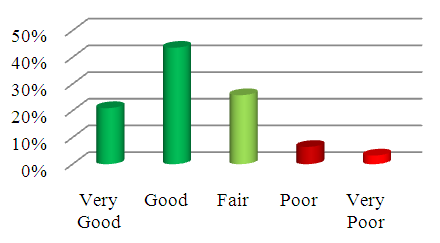 | Figure 1. Quality of internet service |
4.4. Utilization of Shared Services
- Figure 2, represents the utilization and accessibility of the e-government shared services by the surveyed employees. The study reveals that the most utilized shared services are the e-Payslip and GRZ emails. The e-payslip commenced operation in June 2017. About 30% of the respondents use e-Payslip making it being the most utilized shared Service. The utilization of GRZ email stood around 28% slightly below the e-payslip. The rate of the GRZ email utilization may be attributed to the government policy which prohibits access to none government emails on the GWAN. 15% of the respondents use all the shared services with about 5% not using any.
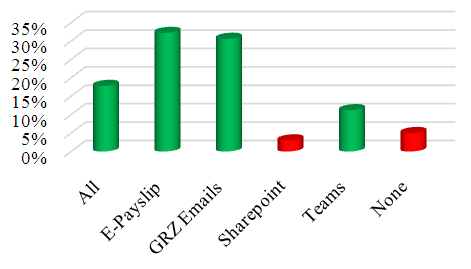 | Figure 2. Frequently utilized shared services |
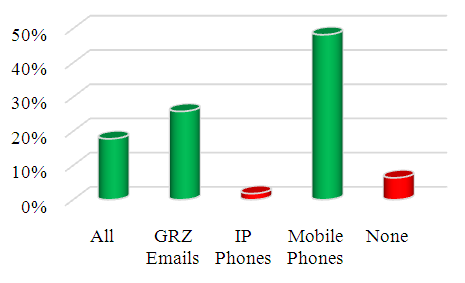 | Figure 3. Most utilized communication options |
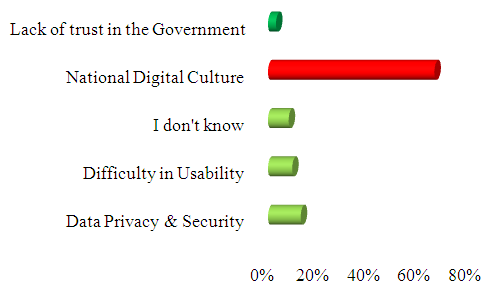 | Figure 4. Reasons for lack of utilization of shared services |
4.5. Chi-square Test of Independence
- Table 5 shows the results of a chi-square test between sensitization and the employee awareness of shared services. H0: There is no association between sensitization and employee awareness of shared servicesH1: There is association between sensitization and employee awareness of shared services
|
 which is also known as the Asymptotic Significance (2-Sided) is 0.001 lower than the critical value
which is also known as the Asymptotic Significance (2-Sided) is 0.001 lower than the critical value  . Therefore, the null hypothesis is rejected. There is a very strong evidence of relationship between sensitization and employee awareness of shared service.
. Therefore, the null hypothesis is rejected. There is a very strong evidence of relationship between sensitization and employee awareness of shared service.4.6. Logistic Regression Model
- Table 6 shows the output of a logistic regression model with “shared services” as a dependent variable and training, sensitization and ICT qualification as independent variables.
|
 listed in the column
listed in the column  is smaller than the critical
is smaller than the critical  of 0.05. There is a very strong evidence of relationship between training and employee familiarity with shared service and between qualification and employee familiarity with shared services. The prediction equation is
of 0.05. There is a very strong evidence of relationship between training and employee familiarity with shared service and between qualification and employee familiarity with shared services. The prediction equation is For every one-unit increase in training for shared services there will be a 1.423 increase in the log-odds of awareness of shared services holding all other variables constant. For every one-unit degrease in ICT related qualification, there is a 1.562 decrease in the log-odds of employee awareness of shared services.
For every one-unit increase in training for shared services there will be a 1.423 increase in the log-odds of awareness of shared services holding all other variables constant. For every one-unit degrease in ICT related qualification, there is a 1.562 decrease in the log-odds of employee awareness of shared services.5. Discussion
- This section provides a notion of the empirical findings. There is limited literature on utilization of network shared services by civil servants. The study extended the idea of how civil servants utilize network shared services for efficiency. Based on the findings from the study and the analysis of data, the levels of utilization and related factors were identified and highlighted. Access to the computer and quality internet is an important foundation for e-government implementation. In this study, 96% of the respondents had access to both the organizational computers and the internet. The GWAN and its associated IT equipment, user computers and internet constituted technical infrastructure necessary for deployment of shared services. The internet on the GWAN was rated to be good. The Government has deployed a network of fiber optic across the government institutions to create an internet backbone that carries the centrally deployed service. However, the utilization of shared services still remains low with only e-pyslip and government email service showing significant utilization. The higher utilization of the government email service compared to other shared services can be attributed to the policy that was introduce a few years ago that prevents access to private email services when using institutional internet connection. The e-payslip which has a direct link to the employees’ livelihood has been digitized and only accessible in electronic form on the GWAN. Many authors have stated that one of the most significant barriers for implementing e-government applications is computer security, privacy and confidentiality of the personal data [23]. It is therefore imperative that the government establishes trust in the online services they provide or will be providing [24]. The study shows that only a handful of civil service employees had concerns with security, data privacy and confidentiality with only 13% showing concerns. The Government has been addressing the cyber security concerns of the citizens through legal frameworks. In 2021, a Cyber Security and Cyber Crime Act was enacted whose one of its purposes was to protect persons against cybercrime. The legislation is now in Parliament as two bills seeking to split the Act into Cyber Security Act 2025 to provide for cyber security in the Republic of Zambia and establish the Zambia Cyber Security Agency and the Cyber Crime Act 2025 which seeks to establish a framework for addressing offences related to computers and computer systems in Zambia. The legal provisions in the two Acts will be strengthened to safeguard the cyberspace. However, according to the respondents, the main reason that contributes to the low utilization of e-government shared services is the poor national digital culture. The Ministry of Education has embarked on providing interventions that address the poor digital culture from early learning. The Ministry has revised its primary and secondary curriculum. The new curriculum which contains the structural adjustment of the education system to align with the global education trends, will be operationalized in February 2025. The curriculum will strengthen Science, Technology, Engineering and Mathematics in school with the introduction of ICT as a subject in primary schools. Literature reveals that training and sensitization is very significant in the adoption and enhances utilization of e-government services. Thought ICT training is most skewed toward the IT personal in civil service, the study finds that most users require in-house training for them to appreciate the e-Services. Training of users is one way of administering sensitization to staff. To save resources, in-house training can be offered by the Human Resource and IT staff in the institutions. Government has appointed change management agents in all public institutions to drive the digital agenda in their institution and also appreciate the civil service employees’ reactions to change and in order to reduce resistance to change.
6. Policy Recommendations
- 1. Strengthen the early childhood school curriculum by ensuring adequate teaching of digital related subjects. 2. The central government should continue increase fund allocation to the implementation of e-government and associated digital projects. 3. Roll out e-government shared services to the rural parts of the country. 4. Develop ICT training and sensitization tools and share with all central government offices in provinces and districts for their in-house training and sensitization.5. Incorporate the awareness of ICTs and e-government services in the induction programmes for new employees. 6. Strengthen the monitoring and evaluation component of the e-government to deal with matters of rejection.
7. Conclusions
- The purpose of this study has been to investigate the main issues that impact on the adoption and utilization of e-government services by civil servants. This study contributes to the extant literature on e-government in central government institutions. The researcher therefore accomplishes that this study extends the knowledge in the aspect of e-government implementation from the organizational perspective (government-to-employee (G2E)), by employing the entrenched institutional theory and validating sensitization, and training as some factors influencing the implementation of e-government. The results show that sensitization and training is significant in e-government implementation. In developing countries like Zambia, lack of awareness is considered to be one of the crucial barriers to introduction, adoption and implementation of new technologies. The researcher defines awareness as: people knowledge and skills of technology. This study has its limitations. This research investigated the adoption of e-government in government institutions in Lusaka Province. While e-government can include a number of technologies and services, this study is restricted to the use of electronic shared services and to one e-government setting: government-to-employee (G2E). The research did not explore those services in e-government that come under the umbrella of government-to-citizen services. It also did not consider the role of other exogenous factors that could impact the behavioural intention to use and actual use of the system. Despite some of these limitations, the researcher believes that this study makes a significant contribution to knowledge in the areas of e-government and technology acceptance and adds to the understanding of enabling factors in developing countries.
Conflict of Interest
- The authors declare no conflicts of interest regarding the publication of this paper. The Author1 is a Public Servant.
 Abstract
Abstract Reference
Reference Full-Text PDF
Full-Text PDF Full-text HTML
Full-text HTML